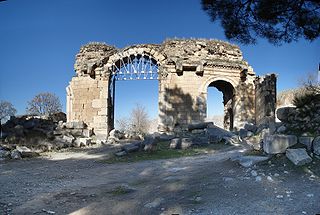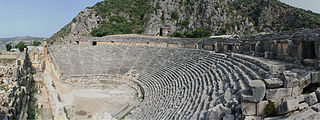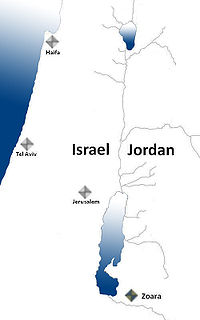Related Research Articles

Anazarbus was an ancient Cilician city. Under the late Roman Empire, it was the capital of Cilicia Secunda. It was destroyed in 1374.

Myra was an ancient Greek, then Roman Greek, then Byzantine Greek, then Ottoman Greek town in Lycia, which became the small Turkish town of Kale, renamed Demre in 2005, in the present-day Antalya Province of Turkey. In 1923 its Greek inhabitants had been required to leave by the Population exchange between Greece and Turkey, at which time its church was finally abandoned. It was founded on the river Myros, in the fertile alluvial plain between Alaca Dağ, the Massikytos range and the Aegean Sea.

Cyzicus was an ancient town of Mysia in Anatolia in the current Balıkesir Province of Turkey. It was located on the shoreward side of the present Kapıdağ Peninsula, a tombolo which is said to have originally been an island in the Sea of Marmara only to be connected to the mainland in historic times either by artificial means or an earthquake.

İskenderun, historically known as Alexandretta and Scanderoon, is a city and the largest district in Hatay Province on the Mediterranean coast of Turkey.

Saint Severus the Great of Antioch, also known as Severus of Gaza, was the Patriarch of Antioch, and head of the Syriac Orthodox Church, from 512 until his death in 538. He is venerated as a saint in the Oriental Orthodox Church, and his feast day is 8 February.

Samosata was an ancient city on the right (west) bank of the Euphrates, whose ruins exist at the previous location of the modern city of Samsat, Adıyaman Province, Turkey but are no longer accessible as the site was flooded by the newly constructed Atatürk Dam. Even though the city had a predominantly Syriac-speaking population, Hellenistic culture played an important role there. The city is sometimes confused with Arsamosata.

:For the modern community, see Arsuf, Hof HaSharon.

Seleucia in Pieria, also known in English as Seleucia by the Sea, and later named Suedia, was a Hellenistic town, the seaport of Antioch ad Orontes, the Seleucid capital, modern Antakya (Turkey). The city was built slightly to the north of the estuary of the river Orontes, between small rivers on the western slopes of the Coryphaeus, one of the southern summits of the Amanus Mountains.

Zoara, the biblical Zoar, previously called Bela, was one of the five "cities of the plain" – a pentapolis apparently located along the lower Jordan Valley and the Dead Sea plain and mentioned in the Book of Genesis. It was said to have been spared the "brimstone and fire" which destroyed Sodom and Gomorrah in order to provide a refuge for Lot and his daughters. It is mentioned by Josephus; by Ptolemy ; and by Eusebius and Saint Jerome in the Onomasticon.

Birecik, also formerly known as Bir, Biré, Biradjik and during the Crusades as Bile, is a town and district of Şanlıurfa Province of Turkey, on the River Euphrates.
The Notitiae Episcopatuum are official documents that furnish Eastern countries the list and hierarchical rank of the metropolitan and suffragan bishoprics of a church.
Gordoservon or Gordoserbon or Gordoserba was a Byzantine city in the region of Bithynia, Asian Minor.

Barbalissos was a city in the Roman province of Euphratensis. Its site is marked by the ruins at Qala'at Balis, which partly retains the old name, south of Maskanah, in modern Syria, on the road from Aleppo to the site of Sura, where the Euphrates turns suddenly to the east.
Titiopolis or Titioupolis was a town of ancient Cilicia and later in the Roman province of Isauria.
Orthosias in Phoenicia was a town in the Roman province of Phoenicia Prima, and a bishopric that was a suffragan of Tyre.

Capitolias was an ancient city east of the Jordan River, and is identified with the modern village of Beit Ras in the Irbid Governorate in northern Jordan. Anciently it was a town of Coele-Syria.

The Council of Pisa was a controversial ecumenical council of the Catholic Church held in 1409. It attempted to end the Western Schism by deposing Benedict XIII (Avignon) and Gregory XII (Rome) for schism and manifest heresy. The College of Cardinals, composed of members of both the Avignon Obedience and the Roman Obedience, who were recognized by each other and by the Council, then elected a third papal claimant, Alexander V, who lived only a few months. He was succeeded by John XXIII.
Zenopolis was an ancient Roman and Byzantine city in Isauria. Its site is located near Elmayurdu in Asiatic Turkey.
Zenopolis was an ancient Roman and Byzantine city and episcopal see variously placed in Lycia or in neighbouring Pamphylia.
The Diocese of Alexandretta is a titular Christian bishopric centred on the town of Alexandretta in Turkey. It is also known as Alexandrinus or Cambysopolis. The bishopric of Alexandria Minor was a suffragan of Anazarbus, the capital and so also the ecclesiastical metropolis of the Roman province of Cilicia Secunda. No longer a residential diocese, Alexandria Minor is today listed by the Catholic Church as a titular see.
References
- Attribution
